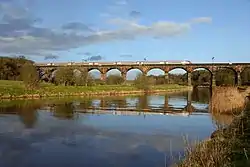Dutton Viaduct
Dutton Viaduct is on the West Coast Main Line where it crosses the River Weaver and the Weaver Navigation between the villages of Dutton and Acton Bridge in Cheshire, England (grid reference SJ581764), not far from Dutton Horse Bridge. It is recorded in the National Heritage List for England as a Grade II* listed building.
Dutton Viaduct | |
|---|---|
 Dutton Viaduct | |
| Coordinates | 53°16′59″N 2°37′43″W |
| Carries | West Coast Main Line |
| Crosses | River Weaver |
| Locale | Dutton, Cheshire |
| Heritage status | Grade II* listed[1] |
| Characteristics | |
| Total length | 500 yards (457 m)[2] |
| Clearance below | 60 feet (18 m)[2] |
| History | |
| Opened | July 1837[3] |
| Location | |
The viaduct was constructed during 1836, and was complete on 9 December of that year. It was the longest viaduct on the Grand Junction Railway (GJR).[3] The viaduct was built at a cost of £54,440 (equivalent to £5,450,000 in 2021).[4] The engineers were Joseph Locke and George Stephenson,[1] and William Mackenzie was its contractor.[5]
Since entering use in July 1837, Dutton Viaduct has remained in regular use. During its operating life, it has been subject to change; during the 1960s, the line was electrified overhead lines and supporting metalwork were installed across its length and its line speed was increased to 125 miles per hour (200 km/h) in the West Coast Main Line route modernisation programme. It became a listed structure in the early 1990s.[1]
History
Background
Dutton Viaduct was constructed for the Grand Junction Railway (GJR), one of the world's first major railways.[3] Joseph Locke and George Stephenson designed the viaduct, which crossed the River Weaver. The route, surveyed by Locke, was relatively free of major engineering challenges, save for the section crossing the Weaver.[6]
The contractor for its construction was William Mackenzie.[1] Dutton Viaduct was the first project to which Thomas Brassey submitted a tender. Brassey lost out to Mackenzie because his estimated cost was roughly £5,000 higher.[5] Brassey was appointed as contractor for the smaller Penkridge Viaduct.[6]
Dutton Viaduct is 60 feet (18 m) high and 500 yards (457 m) long,[2] and comprises 20 deep segmental arches.[1] Primarily built of red sandstone, it has been estimated that roughly 700,000 cubic feet (20,000 m3) of stone was used. The stonework features ashlar dressings, projecting copings, and cutaways on two of the arches that span the river. The pillars of the viaduct have splayed bases, which give the structure a greater degree of stability.[1]
The viaduct cost of £54,440 (equivalent to £5,450,000 in 2021).[4][1] Construction took place during 1836 and completed on 9 December of that year. It was noted at the time that there were no recorded losses of life or serious injury during its construction. Its completion was marked by a civic celebration.[1] On 4 July 1837, the first GJR trains carried passengers across the viaduct before regular operations started.[3]
Operational history
By the 1880s, the Dutton Viaduct was regarded as perhaps one of George Stephenson's finest viaducts.[7] Victorian authors praised its aesthetic qualities.[8]
During the 1960s, the West Coast Mainline was electrified; to facilitate the installation of overhead lines, steel pylons were installed across the viaduct. During the early 1990s, Dutton Viaduct was listed under the Planning (Listed Buildings and Conservation Areas) Act 1990 for its special architectural or historic interest.[1] During the 2000s, work completed for the West Coast Main Line route modernisation permitted the line speed across the viaduct to be raised to 125 miles per hour (200 km/h) and the refuges across the structure for use by trackside workers fell out of use.[9]
During September 2017, a 'near miss' incident was recorded when line-side contractors carrying out a structural inspection crossed the tracks between the obsolete refuges in breach of the red zone regulations. Because of limited trackside clearance, Dutton Viaduct was designated a 'red zone prohibited area' during the previous decade, meaning that workers are not permitted on the line when trains are running unless separated by a permanent fence.[9]
In early 2020, Network Rail applied for permission for repairs to compromised stonework in one of the arches; the remedial work was described as being sympathetic to the bridge's historic construction and designed to blend in with the original materials used.[10]
See also
References
- Historic England. "Dutton Railway Viaduct (Grade II*) (1216523)". National Heritage List for England. Retrieved 10 March 2022.
- The Grand Junction Railway, The Wolverhampton Exhibition of Commerce and Services, archived from the original on 10 July 2008, retrieved 25 November 2007
- Webster, Norman W. (1972), Britain's First Trunk Line, Adams & Dart, p. 86, ISBN 978-0239001054
- UK Retail Price Index inflation figures are based on data from Clark, Gregory (2017). "The Annual RPI and Average Earnings for Britain, 1209 to Present (New Series)". MeasuringWorth. Retrieved 11 June 2022.
- Walker, Charles (1969), Thomas Brassey, Railway Builder, London: Frederick Muller, p. 14, ISBN 0-584-10305-0
- Rolt, L. T. C. "George and Robert Stephenson: The Railway Revolution." Amberley Publishing, 2009. p. 22.
- Frederick Smeeton Williams. "Our Iron Roads: Their History, Construction and Administration." Bemrose, 1885. p. 187.
- Bradshaw. "Bradshaw‛s shilling handbook of Great Britain and Ireland: Section III." W. J. Adams, Bradshaw & Blacklock, 1860. p. 33.
- "Near miss between a train and line-side workers on Dutton Viaduct, Cheshire, 18 September 2017". Rail Accident Investigation Branch. 4 December 2017. Retrieved 7 March 2018.
- Okell, Nathan (16 April 2020). "Plans submitted to repair damage to Grade II-listed Dutton Viaduct". Northwich Guardian. Retrieved 10 March 2022.